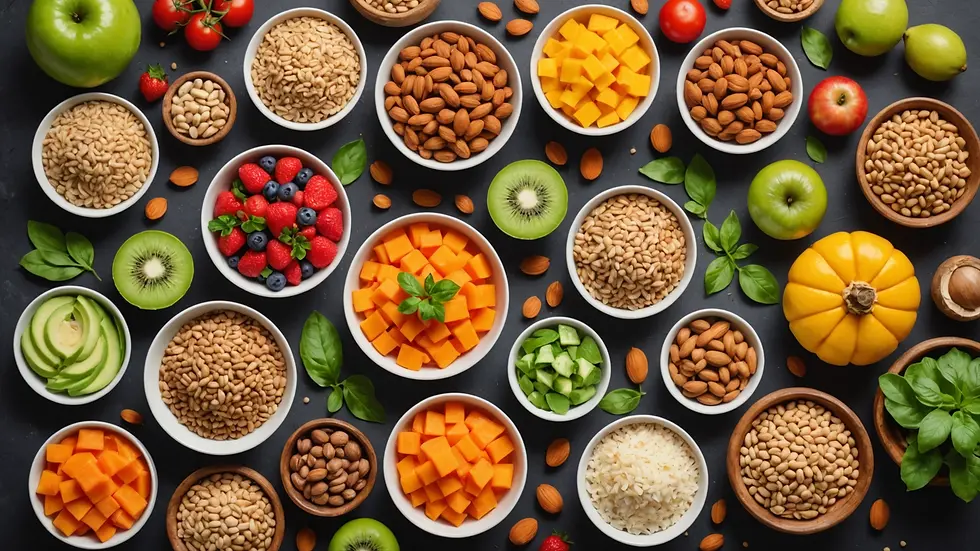The Hidden Power of Fiber: Managing Weight and Improving Digestion in Midlife
- Kim Melton, RD

- Dec 31, 2024
- 4 min read
In midlife, individuals often face significant changes such as hormonal shifts, slower metabolism, and lifestyle transformations. These changes can make managing digestion and weight a real challenge. While many factors contribute to these issues, there’s one often-overlooked hero: dietary fiber. By integrating more fiber-rich foods into our diets, we can unlock a path to better digestion and effective weight management.

Understanding Fiber: What It Is and Why It Matters
Fiber is a unique type of carbohydrate that the body cannot digest. Unlike typical carbs that break down into sugar, fiber remains whole as it moves through our digestive system. It is primarily divided into two types:
Soluble Fiber: This type dissolves in water and aids in lowering cholesterol and regulating blood sugar. Good sources include oats, beans, lentils, apples, and oranges.
Insoluble Fiber: Not soluble in water, this type is crucial for adding bulk to stool and preventing constipation. You can find it in foods like whole grains, nuts, seeds, and the skins of many fruits and vegetables.
Increasing fiber intake offers numerous health advantages, especially for those in midlife who may be managing digestive concerns, weight control challenges, or heightened disease risks.

The Role of Fiber in Digestion
As we age, our digestive functions can weaken, leading to issues like constipation, bloating, and discomfort. Fiber is vital for improving these digestive problems.
Promoting Bowel Regularity
One of fiber's most recognized benefits is promoting bowel regularity. A balanced intake of soluble and insoluble fiber ensures smooth waste movement through the intestines, preventing constipation.
According to dietitians, women in perimenopause and menopause can mitigate constipation by consuming about 25 to 30 grams of fiber daily. This can lead to more consistent and comfortable bowel movements. For instance, including a cup of cooked lentils (about 15.5 grams of fiber) in one meal can significantly boost your daily intake.
Improving Gut Health
Alongside regularity, fiber supports gut health. In the colon, fiber ferments and produces short-chain fatty acids (SCFAs), vital for maintaining a healthy gut microbiome. A well-balanced gut is crucial for overall health and could help alleviate conditions such as irritable bowel syndrome (IBS) and inflammatory bowel disease (IBD), particularly common in midlife.
Reducing Digestive Discomfort
Digestive discomfort often affects many in midlife. Adding fiber-rich foods can reduce bloating and other symptoms. Starting with small portions of fiber can help your digestive system adjust. For example, if you eat a small apple daily with skin (about 4 grams of fiber), gradually increasing your intake can prevent gas and cramping.
Fiber and Weight Management: A Winning Combination
In midlife, managing weight can become more difficult due to a slower metabolism. Fiber is a valuable partner in this journey, helping with fullness and nutritional balance.
Enhancing Satiety and Reducing Appetite
One of fiber's most compelling roles in weight control is enhancing satiety. Fiber-rich foods usually require more chewing and are bulkier, helping individuals feel full longer.
Research shows that adding fiber to meals can lead to a 30% reduction in caloric consumption. For example, a bowl of oatmeal topped with banana and nuts can be a more satisfying breakfast than sugary cereals, helping to curb hunger until lunchtime.
Stabilizing Blood Sugar Levels
Fiber also stabilizes blood sugar, an essential factor for weight management. By slowing the breakdown and absorption of carbohydrates, fiber reduces blood sugar spikes and crashes, which can trigger hunger. This is particularly crucial for midlife individuals, where blood sugar swings can negatively impact mood and energy.
In fact, a recent study revealed that individuals with higher fiber diets had a 25% lower risk of developing type 2 diabetes compared to those with minimal fiber intake.
Encouraging Healthier Food Choices
Focusing on fiber naturally leads to healthier food choices, such as fruits, vegetables, legumes, and whole grains. This switch helps decrease the consumption of processed, calorie-heavy snacks, promoting a well-rounded diet that supports healthy weight.
Practical Tips for Increasing Fiber Intake
Understanding the benefits of fiber is important, but putting it into practice is essential. Here are some straightforward tips to help boost your fiber intake:
Start Slow
If high-fiber foods are new to you, increase your intake gradually to avoid discomfort like bloating or gas. Start with a small serving of fiber-rich foods, such as one serving of beans or whole-grain bread, and increase as your system adapts.
Read Labels
When selecting packaged foods, check nutrition labels for fiber content. Aim for products offering at least 3 grams of fiber per serving. Whole grain items typically provide more fiber than processed alternatives.
Incorporate Whole Foods
Intentionally include whole foods in your meals. Incorporating foods like quinoa, avocados, fruits, and vegetables can significantly increase fiber intake. For example, a single avocado contains approximately 10 grams of fiber.
Experiment with Recipes
Try new recipes that incorporate fiber. Dishes like vegetable stir-fry or soups with beans can make meals both delicious and nutritious. Consider making overnight oats with chia seeds, featuring around 12 grams of fiber per serving, for a healthy breakfast.
Stay Hydrated
As fiber intake increases, so does the need for hydration. Drinking plenty of water (aim for at least 8 glasses daily) is crucial, as it helps fiber effectively do its job.
The Broader Health Benefits of Fiber in Midlife
In addition to digestion and weight management, fiber contributes to overall health, especially important in midlife.
Heart Health
Consuming a high-fiber diet is linked to lower cholesterol levels, thereby potentially reducing heart disease risk. Soluble fiber can bind cholesterol in the digestive system, limiting its absorption into the bloodstream.
Blood Pressure Regulation
Research indicates that individuals with higher fiber consumption generally have better blood pressure management. A study found that those consuming more than 25 grams of fiber daily had a 10% lower risk of hypertension.
Lower Risk of Chronic Diseases
Studies have shown that higher fiber intake is associated with a decreased risk of chronic diseases such as type 2 diabetes and certain types of cancer. The antioxidants in fiber-rich foods can combat inflammation, supporting overall health.

Embracing the Benefits of Fiber
As you navigate the changes of midlife, understanding how fiber can aid digestion and weight management is invaluable. By adopting practical strategies to boost fiber intake, you can enhance your overall well-being. Whether promoting regular bowel movements, stabilizing blood sugar, or supporting heart health, fiber is an essential ally.
Embracing fiber-rich foods not only empowers better dietary choices but also encourages a healthier lifestyle. With consistent effort and awareness, your journey toward improved health can be significantly enriched by the incredible benefits of fiber.






Comentários